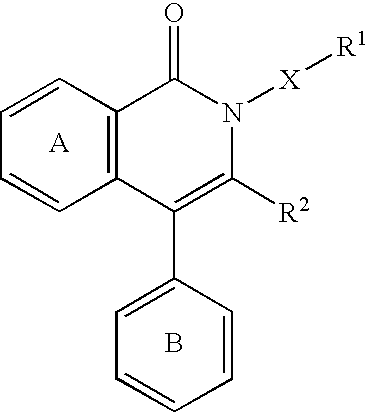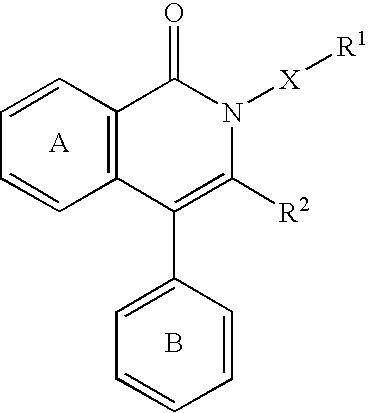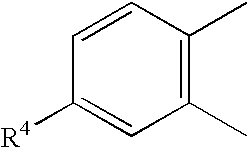Jnk inhibitor
a cjun nterminal kinase and inhibitor technology, applied in the field of jnk inhibitors, can solve the problems that the isoquinolinone derivatives having a jnk inhibitory action have not been reported, and achieve superior properties such as stability and the like, and jnk specific inhibitory activity is superior
- Summary
- Abstract
- Description
- Claims
- Application Information
AI Technical Summary
Benefits of technology
Problems solved by technology
Method used
Image
Examples
reference example 2
6-chloro-4-phenylisocoumarin-3-carboxylic Acid Methyl Ester
[0336] To a solution of 6-chloro-4-phenylisocoumarin-3-carboxylic acid (9 g) in methanol (200 ml) was added sulfuric acid (20 ml) and the mixture was refluxed for 2 hrs. The reaction mixture was concentrated, and the residue was neutralized with aqueous sodium hydrogen carbonate and extracted with ethyl acetate. The organic layer was washed with water and brine, dried over sodium sulfate and concentrated. The residue was crystallized from isopropyl ether to give the title compound (8.7 g) as colorless crystals.
[0337]1H-NMR (CDCl3) δ: 3.72 (3H, s), 7.08 (1H, d, J=2.2 Hz), 7.22-7.30 (2H, m), 7.48-7.55 (3H, m), 7.59 (1H, dd, J=2.2, 8.4 Hz), 8.35 (1H, d, J=8.4 Hz).
reference example 3
6-bromo-4-phenylisocoumarin-3-carboxylic Acid
[0338] To a solution of 4-bromophthalic acid anhydride (100 g) in benzene (500 ml) was added aluminum chloride (118 g), and the mixture was stirred at room temperature for 1 hr. and subsequently refluxed for 30 min. After cooling the reaction mixture, it was diluted with ethyl acetate (200 ml) and poured into ice water. Conc. hydrochloric acid (50 ml) was added and the mixture was stirred at room temperature for 30 min. After separating the organic layer, the layer was washed successively with 4N hydrochloric acid, water and brine, dried over sodium sulfate and concentrated until crystals precipitated. The crude crystals were collected by filtration, and recrystallized from toluene / ethyl acetate (10:1) to give 4-bromo-2-benzoylbenzoic acid (59 g) as colorless crystals.
[0339]1H-NMR (CDCl3) δ: 7.40-7.47 (2H, m), 7.51 (1H, d, J=1.8 Hz), 7.57 (1H, m), 7.68-7.73 (3H, m), 7.94 (1H, d, J=8.7 Hz).
[0340] To a solution of 4-bromo-2-benzoylbenzoi...
reference example 4
6-bromo-4-phenylisocoumarin-3-carboxylic Acid Methyl Ester
[0342] To a solution of 6-bromo-4-phenylisocoumarin-3-carboxylic acid (10 g) in methanol (200 ml) was added sulfuric acid (20 ml) and the mixture was refluxed for 2 hrs. The reaction mixture was concentrated, and the residue was neutralized with aqueous sodium hydrogen carbonate and extracted with ethyl acetate. The organic layer was washed with water and brine, dried over sodium sulfate and concentrated. The residue was crystallized from isopropyl ether to give the title compound (9.76 g) as colorless crystals.
[0343]1H-NMR (CDCl3) δ: 3.72 (3H, s), 7.22-7.30 (3H, m), 7.50-7.57 (3H, m), 7.75 (1H, dd, J=1.8, 8.4 Hz), 8.26 (1H, d, J=8.4 Hz).
PUM
| Property | Measurement | Unit |
|---|---|---|
| Mass | aaaaa | aaaaa |
| Mass | aaaaa | aaaaa |
| Mass | aaaaa | aaaaa |
Abstract
Description
Claims
Application Information
 Login to View More
Login to View More - R&D
- Intellectual Property
- Life Sciences
- Materials
- Tech Scout
- Unparalleled Data Quality
- Higher Quality Content
- 60% Fewer Hallucinations
Browse by: Latest US Patents, China's latest patents, Technical Efficacy Thesaurus, Application Domain, Technology Topic, Popular Technical Reports.
© 2025 PatSnap. All rights reserved.Legal|Privacy policy|Modern Slavery Act Transparency Statement|Sitemap|About US| Contact US: help@patsnap.com



